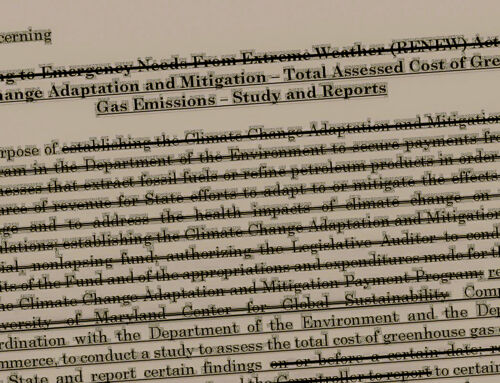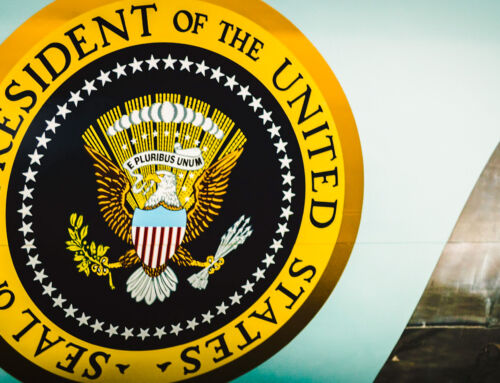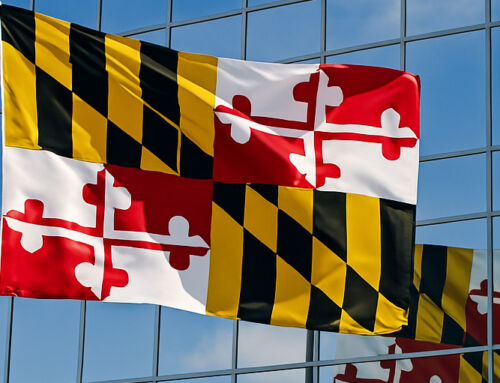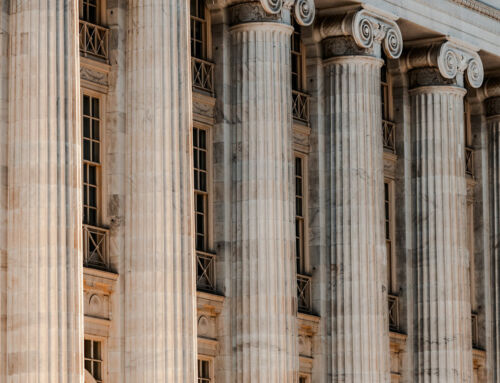View by Topic
Recent Articles
-
New Environmental Laws from the 2025 Maryland Legislative SessionSaturday, April 26th, 2025
-
Migratory Bird Treaty Act Does Not Prohibit Incidental Take – AgainSaturday, April 19th, 2025
-
President Trump’s Bold Step to Rein in State Overreach in Climate ChangeSaturday, April 12th, 2025
-
Mandatory GHG Disclosures in Maryland Real Estate ContractsSaturday, April 5th, 2025
-
NYC Building Electrification Ruling is Interesting But Not a Game ChangerSaturday, March 29th, 2025
View by Month/Year
“Green Building Law Update” Headlines
Recent Articles & News from
Stuart Kaplow’s blog
at GreenBuildingLawUpdate.com
- New Environmental Laws from the 2025 Maryland General Assembly Session April 27, 2025
- Migratory Bird Treaty Act Does Not Prohibit Incidental Take – Again April 20, 2025
- President Trump’s Bold Step to Rein in State Overreach in Climate Change April 13, 2025
- Mandatory GHG Disclosures in Maryland Real Estate Contracts April 6, 2025
Subscribe to the Green Building Law Update!
Stuart Kaplow brings his expertise and extensive experience to the table with his unique digital publication, "Green Building Law Update". Subscribers receive regular updates to keep them informed about important issues surrounding Environmental Law, Green Building & Real Estate Law, as well as the emerging demand for Environmental Social Governance (ESG).
Get fresh content through the lense of Stuart Kaplow's cutting-edge expertise, innovative commentary and insider perspective. Don't miss another issue! Subscribe below.
Warning: Green Building Litigation .. Really?
Despite the hue and cry over increased liability and the legal risk of Green building and sustainable development, there is not a single reported appellate court decision anywhere in the United States arising out of Green building.
That void must be considered against the backdrop of real estate and building, among the most heavily regulated industries, where courts are frequently called upon to resolve disputes and differences.
It would then appear self evident, with no litigation there is no increased legal exposure for Green building nor are there new liabilities simply because the construction is of a building that is more resource efficient and environmentally responsible, will have lower anticipated operating costs and increased asset value, as well as enhanced occupant comfort and health.
However, if that underlying assumption that there are no court challenges is accepted as true, then why are insurance carriers seeing a significant rise in claims related to construction of buildings that are Green? Claims are being lodged against contractors and design teams under theories of design defect, of third party certification as Green a guarantee, of Green measures as performance specifications, of responsibility for delays arising from Green materials, etc.
Arbitration no longer required
The lack of appellate judicial review of matters of Green building should not be surprising for several reasons, the most significant being that many, if not most, disputes in this field are governed by sophisticated contract documents that require mediation and arbitration. Design and related services and construction contracts often utilize the American Institute of Architects (“AIA”) contract documents that have mandated mediation and arbitration such that there is little, if anything left to litigate.
However, this is changing. After decades of requiring mediation and binding arbitration, the new and current AIA contract documents (e.g., AIA B101 – 2007 Standard Form of Agreement Between Owner and Architect™) have a ‘check the box’ for method dispute resolution that has most owners selecting litigation by a court of competent jurisdiction in lieu of alternative dispute resolution. Such portends more judicial redress in the broader building industry as well as in the Green building marketplace.
The only litigation to date
It has been widely reported that the only Green building litigation in the country, to date, has been the trial court case (as opposed to a court of appeal whose decision would have precedential value) in Maryland, Southern Builders, Inc. v. Shaw Development, LLC, in the Circuit Court of Maryland for Somerset County, case 19-C-07-011405 (2007). However, as described below, that case was dismissed before any adjudication on the merits and while it provides no value as a precedent, the pleadings offer guidance as to possible future causes of action.
In the Southern Builders case, disputes and difference arose out of the construction of a $7.5 Million, 23 unit luxury condominium and restaurant project in Crisfield, Maryland, called Captain’s Galley and substantially completed in 2006. In January 2007, Southern Builders, the general contractor, commenced a mechanics lien action in the Circuit Court. A counterclaim was filed by Shaw Development alleging breach of contract and negligence. Significantly, a motion to stay proceedings and compel arbitration was granted by the court in response to the contract provision (the parties having utilized a predecessor to the AIA B101 – 2007™) that mandated binding arbitration. In advance of arbitration, the disputes and differences were resolved between the parties and a stipulation of dismissal was filed with the Court in June 2007.
Despite that relatively simple procedural history, much has been written about the case, largely overstating an allegation in the counterclaim that claimed,
“10. Specifically, the Project Manual and Scope of Work required Southern Builders to construct an environmentally sound “Green Building,” in conformance with a “Silver Certification Level according to U.S. Green Building Council’s Leadership in Energy & Design (LEED) Rating System,” as more specifically set forth in the Project Manual and Project Specifications, Division I Section “LEED Requirement.” .. .. In failing to comply with this contractual requirement, Shaw Development will suffer damages in the amount of a Six Hundred Thirty-Five Thousand Dollar ($635,000.00) tax credit.”
The only relevant contract provision provided,
“D. The Work consists of the following: .. .. 2. Project is designed to comply with a Silver Certification Level according to the U. S. Green Building Council’s Leadership in Energy & Design (LEED) Rating System, as specified in Division I Section LEED Requirements.”
Counsel for Shaw Development reported that the settlement between the parties was not impacted by matters of Green building, but was an ordinary construction dispute that began as a mechanics lien action for failure to pay and resulted in the developer executing a $54,000.00 promissory note, secured by a mortgage on the project, to be paid out of proceeds from the sale of the condominium units. As of January 12, 2009, the project had not registered seeking LEED certification and none of the units had closed when Shaw Development filed for Chapter 11 bankruptcy protection in response to a scheduled foreclosure auction by the project’s lender.
Southern Builders is instructive because, commenced as a mechanics lien action for failure to pay, this is how many construction disputes, including those that will involve matters of Green building, will reach the courts. Those cases are often defended with counterclaims under any number of other causes of action from breach of contract and breach of warranty to negligence and misrepresentation.
No new legal exposure
Significantly, there is not new legal exposure in building Green, but rather, the same claims and causes of action that are common in real estate and construction disputes are now being manifested in the ever increasing number of Green buildings. That is not to say that the involvement of those unfamiliar in the ways of Green building will not result in potential liability that is unique to this building type (e.g., the failure to schedule the multi day indoor air quality management flush out of the premises, specifying the use of Green building materials not in the market place long enough to have reliable performance data, etc.).
Mandatory green building laws
Mandatory laws that require a private owner to construct to a Green building standard will no doubt move the question of who is liable for the failure to obtain LEED® certification to the courts. When the local government will not issue a use and occupancy certificate because the building does not obtain a LEED Silver certification (i.e., Baltimore City and elsewhere), the parties will look to its contract documents to see who has liability.
Unfortunately, the form document apparently most commonly used when providing LEED certification services, does not apportion responsibility or liability? The AIA Document B214™, intended to modify an agreement between an owner and architect, is an excellent checklist of services necessary to obtain LEED certification, but the writing fails to clarify expectations as to who will accomplish what and as such fails to protect the architect or the owner? The form document needs to be modified before use to minimize the risk of legal liability.
Moreover, in the era of mandatory Green building laws it is not clear that a contractor bound to build according to an architect’s plans and specifications will not be responsible for the consequences of failure to achieve third party certification required to comply with those laws.
Additionally, mandatory Green building laws enacted at the local government level will result in challenges and adjudications at the administrative law level against the government body itself and that will give rise to a judicial review of an administrative decision or a mandamus action to compel the local code official to act.
Another large category of mandatory Green building claims in waiting is that the Energy Independence and Security Act of 2007 mandate that starting in 2010 the federal government occupy only Green buildings achieving a minimum Energy Star designation. For those who lease buildings to governments, ever increasing numbers of state and local governments are also enacting mandates that future leases be in Green buildings. Owners leasing to government will need to have Green premises.
That the Green Building Certification Institute “reserves the right to revoke LEED certification from any LEED 2009 project upon gaining knowledge of non-compliance ..” creates legal risk and potential liability into the future, requiring that contracts address this potential eventuality, as rare as it might appear to be.
There are other very real legal implications of LEED certification that impact not only current owners but also burden purchasers when “all certified projects in LEED 2009 must commit to allow USGBC to assess all available actual whole project energy and water usage data in the future for research purposes. This commitment must carry forward if the building changes ownership ..” and, as such, will now have to translated into provisions included in purchase contracts and leases.
Marketing green
Marketing claims that buildings are “green” or that building products are “environmentally friendly” give rise to potential consumer and government court challenges for false or misleading claims. Sellers and marketers are now making Green claims for a wide variety of buildings and products, including such terms as “sustainable” and “eco friendly.” In response to these market shifts, the Federal Trade Commission hosted a workshop last year “to examine developments in green building” including how the public interprets Green claims and the substantiation necessary to support them.
Green leases
And in another area of potential litigation, occupants in commercial Green buildings, and, in particular in multi tenant buildings, have begun pursuing claims against owners when their expectations are not met. The need to address matters of Green building in leases is one of the largest failings in commercial real estate today. Claims arising from poorly drafted leases or arising from leases that do not touch upon Green building matters, will certainly be fertile ground for litigation in coming years.
All of which harkens to a single theme that the risk associated with Green building may be mitigated with good, precise and uniquely drafted contract language.
Less risk in green buildings
Of great importance is that many commentators and apparently the property insurance market believe there is actually less risk in a Green building. At least five national insurers have issued Green enhancements to their standard property forms or specific Green insurance policies that offer significant discounted pricing for building owners and tenants who commit to Green standards. The rationale is that with ‘state of the art’ electrical, plumbing and roof systems, Green buildings experience fewer incidents of risk and loss.
Mitigate your risk
The market shift toward Green building is resulting in tens of thousands of Green buildings being constructed. There are over 35,000 buildings registered and in the process of seeking LEED certification alone. This huge number does not take in to account buildings making application to any of the other third party Green building certification programs (i.e., Green Globes®, BREEAM®, etc.), and does not count buildings being constructed Green but for which the owner is not seeking a third party validation.
With that massive market shift, disputes and differences in Green building will soon be the rule rather than the exception.
Green building law presents a fast evolving landscape of statutes, regulations, private agreements, and risk of liability. Today that landscape is set by the environmental policy of the time, global climate change. Businesses need to alter their practices now will need to continue adapt quickly to the changing legal climate and marketplace. Even though we are in the nascency of addressing climate change, many initiatives already impact upon real estate.
Green building law is in its infancy. This article is by no means a comprehensive treatment of the subject of the legal risks of building Green. This author’s goal is modestly to assist you in participating in the Green building revolution by providing guidance on mitigating risks and avoiding the disputes and differences that are to come.
Most of the risk associated with Green building today can be averted with good, precise and uniquely drafted contract language. It is time to now revise your contracts, leases and other written agreements!









